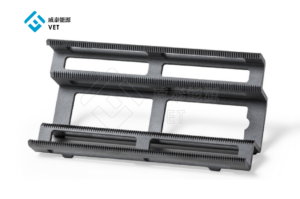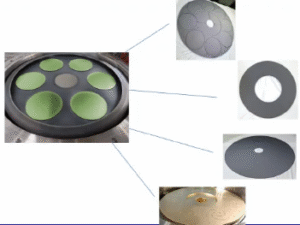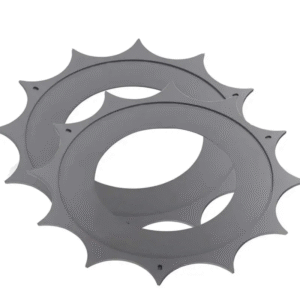Graphite susceptor heating technology has revolutionized high-temperature processes in 2025. Industries now benefit from its precision and efficiency. Graphite susceptor induction heating enables advanced material processing, while innovations in graphite coating enhance durability. These advancements drive progress in semiconductors, renewable energy, and manufacturing, redefining performance standards and fostering sustainable industrial practices.

Key Takeaways
- Graphite susceptor heating makes high-heat work more accurate and fast. It helps industries like computer chips and green energy.
- New coating methods, like plasma chemical vapor deposition, make graphite susceptors stronger and work better.
- Silicon carbide coatings improve heat flow, spread heat evenly, and make heating systems last longer.
Technological Advancements
Innovations in precision coating techniques
Precision coating techniques have undergone significant advancements in 2025. Engineers now utilize state-of-the-art deposition methods to create uniform and defect-free coatings on graphite susceptors. These techniques enhance the material’s resistance to wear and oxidation, ensuring longer operational lifespans. Plasma-enhanced chemical vapor deposition (PECVD) has emerged as a leading method, offering unparalleled control over coating thickness and composition. This precision allows manufacturers to tailor coatings for specific industrial applications, improving performance in demanding environments.
Additionally, automation has streamlined the coating process. Robotic systems ensure consistent application, reducing human error and increasing production efficiency. These innovations have made precision coating techniques more accessible to industries requiring high-temperature processes, such as semiconductor manufacturing and advanced material processing.
Enhanced thermal performance with SiC coatings
Silicon carbide (SiC) coatings have redefined thermal performance in graphite susceptor heating technology. SiC’s exceptional thermal conductivity and stability at high temperatures make it an ideal choice for enhancing heat transfer efficiency. By applying SiC coatings, manufacturers achieve uniform heat distribution, minimizing thermal gradients that could compromise material integrity.
These coatings also provide superior resistance to chemical corrosion, extending the lifespan of graphite susceptors in harsh environments. Industries utilizing graphite susceptor induction heating benefit from SiC’s ability to maintain consistent performance under extreme conditions. This advancement has proven particularly valuable in applications requiring precise thermal control, such as silicon carbide bonding and wafer processing.
Cost-effectiveness and scalability improvements
Recent developments have significantly reduced the cost of producing graphite susceptors with advanced coatings. Innovations in material sourcing and manufacturing techniques have lowered production expenses without compromising quality. Scalable production methods, including additive manufacturing, have further enhanced cost-effectiveness. These methods allow manufacturers to produce complex susceptor designs with minimal waste.
The scalability of these technologies ensures that industries of all sizes can adopt graphite susceptor induction heating systems. Small-scale manufacturers now have access to high-performance solutions previously limited to large enterprises. This democratization of technology has accelerated its adoption across various sectors, driving innovation and economic growth.
Graphite Susceptor Induction Heating

Applications in high-temperature processes
Graphite susceptor induction heating has become indispensable in high-temperature industrial processes. Its ability to deliver precise and consistent heat makes it ideal for applications such as crystal growth, chemical vapor deposition, and sintering. These processes demand extreme thermal stability, which graphite susceptors provide through their excellent heat retention and uniform energy distribution. Industries like aerospace and electronics rely on this technology to manufacture components that require exacting thermal conditions.
The versatility of graphite susceptor induction heating extends to its compatibility with various materials. It supports the processing of metals, ceramics, and semiconductors, enabling manufacturers to achieve superior product quality. This adaptability has positioned it as a cornerstone of modern high-temperature operations.
Benefits for silicon carbide bonding
Silicon carbide bonding processes benefit significantly from graphite susceptor induction heating. The technology ensures precise thermal control, which is critical for achieving strong and defect-free bonds. By maintaining consistent temperatures, it minimizes thermal stress and prevents material deformation. This capability has proven essential in producing high-performance components for power electronics and renewable energy systems.
Graphite susceptor induction heating also enhances the efficiency of silicon carbide bonding by reducing energy waste. Its rapid heating and cooling cycles optimize production timelines, allowing manufacturers to meet growing demand without compromising quality.
Modulated thermal energy delivery systems
Modulated thermal energy delivery systems represent a breakthrough in graphite susceptor induction heating. These systems allow operators to fine-tune heat output based on specific process requirements. By adjusting energy delivery in real-time, manufacturers can achieve unparalleled precision and efficiency.
This innovation reduces energy consumption and extends the lifespan of graphite susceptors. It also enables greater control over complex processes, such as multi-layer material deposition. Industries adopting modulated systems report improved product consistency and reduced operational costs, highlighting the transformative potential of this advancement.
Applications Across Industries
Role in semiconductor manufacturing processes
Graphite susceptor induction heating has become a cornerstone in semiconductor manufacturing. This technology ensures precise thermal control during critical processes like wafer fabrication and epitaxial layer deposition. Manufacturers rely on its ability to deliver consistent heat, which is essential for producing defect-free semiconductor wafers. The uniform energy distribution provided by graphite susceptors enhances the quality of microchips, enabling advancements in computing and electronics.
The adoption of this technology has also streamlined production timelines. Faster heating and cooling cycles reduce downtime, allowing manufacturers to meet the growing demand for semiconductors. As the industry continues to push the boundaries of miniaturization, graphite susceptor induction heating plays a pivotal role in achieving the precision required for next-generation devices.
Contributions to renewable energy technologies
Renewable energy systems benefit significantly from advancements in graphite susceptor heating. In solar panel production, this technology supports the creation of high-purity silicon, a critical component for photovoltaic cells. Its ability to maintain stable temperatures ensures the efficiency and durability of solar panels, driving the adoption of clean energy solutions.
In addition, graphite susceptor induction heating contributes to the development of energy storage systems. It facilitates the production of advanced battery materials, such as silicon anodes, which improve energy density and charging speeds. These contributions accelerate the transition to sustainable energy sources, addressing global energy challenges.
Impact on advanced manufacturing and material processing
Advanced manufacturing processes leverage graphite susceptor induction heating to achieve unparalleled precision and efficiency. This technology supports the fabrication of high-performance materials, including ceramics and composites, used in aerospace and automotive industries. Its ability to handle extreme temperatures ensures the structural integrity of these materials, meeting the rigorous demands of modern engineering.
Material processing applications also benefit from this innovation. Graphite susceptors enable uniform sintering and bonding, improving the quality of finished products. By optimizing energy usage, this technology reduces operational costs while maintaining high production standards. Its versatility continues to drive innovation across diverse manufacturing sectors.
Sustainability and Environmental Impact
Adoption of eco-friendly production practices
Industries have embraced eco-friendly production practices to align with sustainability goals. Graphite susceptor heating technology now incorporates renewable energy sources, such as solar and wind power, to reduce reliance on fossil fuels. Manufacturers have optimized production processes to minimize waste and conserve resources. For instance, recycling graphite materials has become a standard practice, reducing the need for raw material extraction.
Automation has further enhanced sustainability by improving energy efficiency. Advanced systems monitor and adjust energy consumption in real time, ensuring minimal waste. These practices demonstrate a commitment to reducing the environmental footprint of industrial operations.
Compliance with global environmental regulations
Compliance with international environmental standards has become a priority for manufacturers. Regulations such as the Paris Agreement and ISO 14001 have driven industries to adopt cleaner technologies. Graphite susceptor heating systems now meet stringent emission standards, ensuring adherence to global guidelines.
Manufacturers conduct regular audits to ensure compliance. They also invest in research to develop technologies that exceed regulatory requirements, positioning themselves as leaders in sustainable innovation.
Reduction of carbon footprint in industrial applications
Graphite susceptor heating technology has significantly reduced the carbon footprint of industrial processes. Its energy-efficient design minimizes greenhouse gas emissions. By utilizing renewable energy and optimizing thermal performance, manufacturers achieve substantial reductions in energy consumption.
- Key benefits:
- Lower operational emissions.
- Reduced dependency on non-renewable energy.
- Enhanced energy efficiency in high-temperature processes.
These advancements contribute to global efforts to combat climate change. Industries leveraging graphite susceptor heating technology play a vital role in creating a sustainable future.
Market Trends and Challenges
Regional growth and adoption trends
The adoption of graphite susceptor heating technology has surged across key regions in 2025. Asia-Pacific leads the market, driven by its dominance in semiconductor manufacturing and renewable energy production. Countries like China, South Korea, and Japan have invested heavily in advanced manufacturing technologies, fueling demand for graphite susceptors. North America follows closely, with the United States spearheading innovations in aerospace and material processing industries.
Europe has also witnessed significant growth, particularly in Germany and France, where industries prioritize sustainable practices. These regions benefit from government incentives and research funding aimed at promoting eco-friendly technologies. Emerging markets in South America and Africa are gradually adopting graphite susceptor systems, leveraging their cost-effectiveness and scalability to modernize industrial operations.
Addressing production and supply chain constraints
Manufacturers face challenges in securing raw materials for graphite susceptor production. Limited availability of high-purity graphite and silicon carbide has created supply bottlenecks. To address this, companies are exploring alternative sourcing strategies, including partnerships with mining firms and investments in synthetic graphite production.
Supply chain disruptions caused by geopolitical tensions and global pandemics have further complicated logistics. To mitigate risks, manufacturers are diversifying their supplier base and adopting localized production models. Automation and digital supply chain management tools have also improved efficiency, ensuring timely delivery of critical components.
Future opportunities and emerging markets
The future of graphite susceptor heating technology lies in its expansion into untapped markets. Industries such as biotechnology and quantum computing present new opportunities for high-precision thermal systems. The growing demand for electric vehicles (EVs) also drives innovation, as manufacturers seek advanced materials for battery production.
Emerging markets in Southeast Asia and the Middle East offer significant growth potential. These regions are investing in infrastructure and industrial modernization, creating a favorable environment for adopting advanced heating technologies. Companies that capitalize on these opportunities will shape the next phase of market evolution.
Graphite susceptor heating technology in 2025 showcases remarkable advancements in precision, efficiency, and sustainability. Industries benefit from its transformative role in enhancing production quality and reducing environmental impact. Future innovations promise broader applications, particularly in emerging markets and advanced sectors. This technology continues to shape industrial progress and global sustainability efforts, driving innovation forward.
For more product details, please contact steven@china-vet.com Or website: www.vet-china.com.







